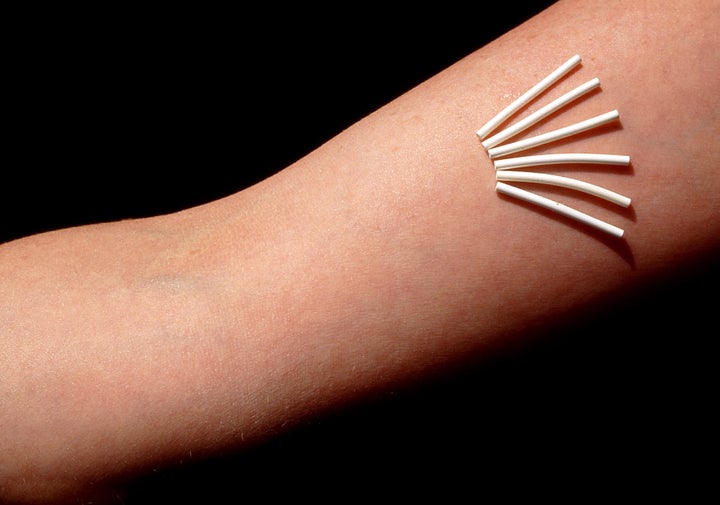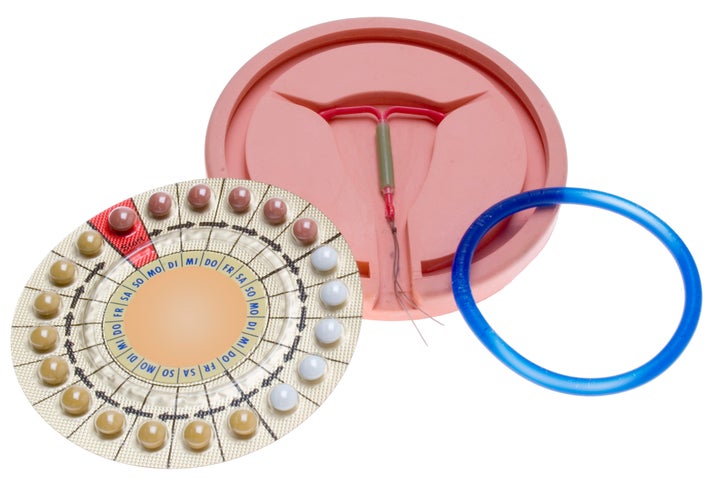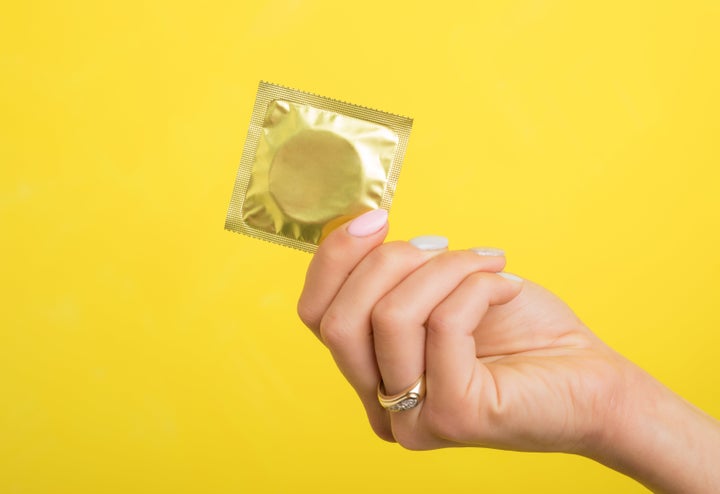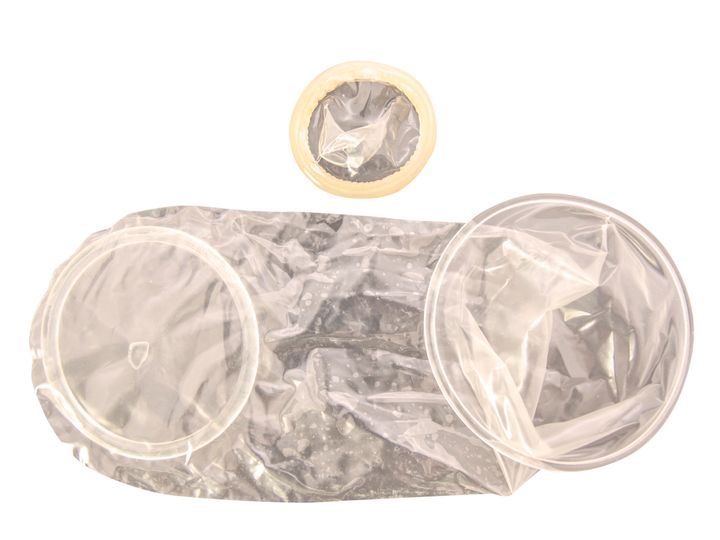There are several types of contraception method, including hormonal, barrier, intra-uterine devices (IUDs), natural, and sterilisation.
We will now go through them from most to least reliable.
Contraceptive implant (99.9% effective)

The implant is about the size of a thin matchstick and is inserted under the skin of the upper arm using local anaesthetic. It contains the hormone progestogen, which prevents the ovary from releasing an egg and thickens the cervical mucus (also known as discharge) to act as a barrier to sperm.
Pros
- Once fitted you do not have to think about contraception and it does not interfere with sex
- It lasts for three years but can be removed at any time by a doctor or nurse and normal fertility will return
- It offers highly effective protection against pregnancy. If implanted correctly, it’s more than 99% effective
- It is useful for women who know they do not want to get pregnant for a while
- It is useful for women who cannot use contraception that contains oestrogen and for those who find it hard to remember to take a pill daily.
Cons
- At first, you may feel some bruising, tenderness or swelling around the implant
- In the first year after the implant is fitted, your periods may become irregular, lighter, heavier or longer – although this usually settles down after the first year
- A common side effect of the implant is that your periods stop completely
- Some medications can make the implant less effective. Therefore additional contraceptive precautions need to be followed when you are taking these medications.
Intrauterine device (IUD; ‘Coil’; 99.2% Effective)

An IUD is a small plastic T-shaped device that continuously releases a small amount of the hormone progestogen, which interferes with implantation and thickens cervical mucus to act as a barrier to sperm.
It requires a simple procedure, carried out by a doctor or nurse, to insert it into the uterus. Two brands of IUD used in the UK are Mirena and Jaydess.
Pros
- Once fitted you do not have to think about contraception and it does not interfere with sex
- It can be left in place for up to 10 years but can be removed at any time by a doctor or nurse and normal fertility will return
- It is suitable for people who are unable to use hormonal methods
- It is not affected by any other medicines
- An IUD can also be used as emergency contraception and is more effective at preventing pregnancy than taking an emergency pill.
Cons
- In contrast to the IUD, periods may become heavier, longer or more painful. However, improves after a few months
- There is a low risk of an ectopic pregnancy, but only if you happen to become pregnant while using an IUD.
Contraceptive injection (94% effective)

An injectable form of the hormone progestogen, which prevents the ovary from releasing an egg.
The injection is another long-acting method which lasts for 13 weeks. It’s highly effective if you use it according to instructions and always have your next injection at the right time.
If you do not always do this then it is less effective – the way it is typically used means around six in 100 injection-users become pregnant in a year.
Pros
- It does not interfere with sex and you do not have to think about contraception for three months after injection
- It may reduce heavy painful periods and help with premenstrual symptoms for some women
- It is not affected by any other medicines.
Cons
- It can cause unpredictable bleeding, however periods usually become lighter or stop altogether
- You may experience weight gain with this method, but not all women do
- The injection takes 12 weeks to leave the body if side effects do occur
- It can take up to a year for fertility to return to normal after using it, which means it is not suitable if you want to get pregnant in the near future.
Combined pill (91% Effective)

The pill is made of synthetic hormones similar to those found naturally in a woman’s body. It works by preventing the ovary from releasing an egg.
The combined pill is still one of the most commonly used methods of contraception and is often one of the few methods on offer from GP surgeries.
Pros
- It usually makes bleeds regular, lighter and less painful
- Studies have found that it reduces the risk of cancer of the ovary, uterus and colon
- Normal fertility returns as soon as you stop using it.
Cons
- There can be a range of side-effects such as headaches, nausea, mood changes and breast tenderness
- It can have some serious side-effects in a small number of women, such as a blood clot (deep vein thrombosis (DVT) or pulmonary embolus (PE)), heart attack or stroke, but these are not common
- Missing a pill, vomiting or severe diarrhoea can make it less effective
- May not be suitable if you smoke and are over 35 years old
- Some types of medicine might make it less effective, including ones used to treat epilepsy, HIV and TB, and the complementary medicine St John’s Wort
- It must be taken daily to prevent pregnancy, at the same time of day.
Progestogen-only (‘mini-pill’) pill (91% effective)

The progestogen-only pill (also known as the mini pill) is also taken at the same time, every day. Unlike with the combined pill, there is no seven-day break.
There are two types of progestogen-only pills: both thicken the cervical mucus to prevent the sperm from reaching the egg, some also prevent the ovary from releasing an egg each month.
Pros
- Unlike the combined pill, the mini pill doesn’t contain oestrogen so it’s useful for women who can’t use the hormone
- It can be used if you smoke and are over 35 years old
- It can help with premenstrual symptoms and painful periods
- It does not interfere with sex
- Normal fertility returns as soon as you stop using it.
Cons
- It can cause irregular bleeding
- Missing a pill, vomiting or severe diarrhoea can make it less effective
- It must be taken at the same time every day to work properly
- Some types of medicine might make it less effective, including ones used to treat epilepsy, HIV and TB, and the complementary medicine St John’s Wort.
Contraceptive patch (91% effective)

A lesser-known contraceptive, the 4cm square plastic patch sticks to the skin and releases hormones into the bloodstream.
Unlike the pill, which is taken daily, new patches are usually applied weekly.
Pros
- It does not interfere with sex
- It is not affected by vomiting and diarrhoea
- Periods may become regular, lighter and less painful
- Normal fertility returns when you stop using it.
Cons
- It may be seen on the skin or cause skin reactions
- It can fall off without you noticing
- May not be suitable if you smoke and are over 35 years old
- Some types of medicine might make it less effective, including ones used to treat epilepsy, HIV and TB, and the complementary medicine St John’s Wort.
Vaginal ring (91% effective)

A flexible, transparent, plastic ring which a woman places inside the vagina herself (like a tampon). It is left in place for three weeks and then removed, at which point a woman will usually then have her period. One week later, users add a new ring and start the cycle again. This method of contraception releases the same hormones used in the combined pill, which prevent the ovary from releasing an egg.
Pros
- It does not interfere with sex
- You don’t have to have to think about it everyday
- It is not affected by vomiting and diarrhoea
- Periods may become regular, lighter and less painful
- Normal fertility returns when you stop using it.
Cons
- It may not be suitable if you smoke and are over 35 years old
- In rare instances it may fall out during sexual intercourse or while straining during a bowel movement
- It has been associated with an increased risk of blood clots, stroke or heart attack. Anyone with a history of these conditions or any condition that makes your blood more likely to clot should avoid using it.
Diaphragm and cervical caps (88% effective)

Diaphragms are circular domes made of thin, soft latex or silicone with a flexible rim, while cervical caps are smaller and are made of latex or silicone. They are barrier methods of contraception, which means they prevent sperm and egg from meeting. They fit inside the vagina and cover the cervix (the entrance to the womb).
Pros
- You only need to use them when you have sex
- They have no serious health risks or side effects.
Cons
- To be effective, diaphragms and caps need to be used with a spermicide. This can be messy to use and some people can be sensitive to it
- They come in different shapes and sizes, so you will need to see a doctor or nurse first to ensure it fits correctly
- You need to learn how to use it to cover the cervix properly.
Male condoms (82% effective)

Male condoms are still one of the most popular methods not least because they also help protect you from sexually transmitted infections and they are so widely available,” says Nikita Halil.
Pros
- They protect against sexually transmitted infections as well as pregnancy
- They are good for people who don’t want to use hormonal methods
- They aren’t expensive, are easy to access and you can often get them for free
- They come in different shapes, sizes and flavours, which can make sex more fun.
Cons
- You have to interrupt sex to put one on
- It can split or slip off
- Oil-based products (like body oils, hand creams and vaseline) can damage the latex and make the condom more likely to split. So always use water-based lubricants.
Female condoms (79% effective)




